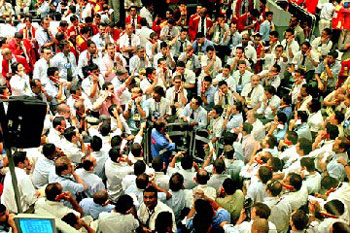 This is a pretty good synopsis of history’s greatest boom in the demand for financial paper. The Elliott Wave Financial Forecast covered the implications in a January Special Section, “2007: THE YEAR OF FINANCIAL FLAMEOUT.” Here’s an excerpt: This is a pretty good synopsis of history’s greatest boom in the demand for financial paper. The Elliott Wave Financial Forecast covered the implications in a January Special Section, “2007: THE YEAR OF FINANCIAL FLAMEOUT.” Here’s an excerpt:
Even the most pessimistic economists and central bankers see little sign that the liquidity boom, and the benign financial environment that it has fostered will disappear soon. Confidence in the current environment stems from financial innovations and new financial players that have helped disperse risk more quickly and more broadly than ever before. While the argument that things are different has always been dangerous, many economists now subscribe to the brave new cycle, or a cycle in which the ups and downs have become much more muted, largely thanks to the stabilizing influence of new financial technology.
A cycle that doesn’t cycle? We heard the same thing in January 2000 when belief in the New Economy grabbed hold amid assurances that the business cycle had become an anachronism. This time, “financial innovation” replaces technology as the holy grail of economic growth. Our chart shows that the influence of finance has been growing for three decades, but only now is its “magnitude and persistence” itself the reason for the boom. The psychology is so powerful, and dangerous, that many of the financial system’s most fundamental weaknesses are listed as strengths: it’s “easier for the less creditworthy to borrow than ever before;” “the biggest banks don’t hold much debt, having sold it on to others;” securitization has distributed debts “far and wide, so no single holder has significant exposures;” derivatives insure “the holders of debt against losses.” But the pervasive spread of risk doesn’t mitigate it, it simply intensifies it and snares everyone.
One of the things the subprime experience shows us is just how wrong the pundits were when they said, “The biggest banks don’t hold much debt, having sold it on to others.” Within a few weeks of that statement, realizations hit about how dangerous the boom in mortgage securitization is because banks passed on much of the riskiest mortgages to far flung individuals and pension funds. Turns out these are very cumbersome to deal with in the event of default. The subprime experience also points out that many instruments don’t pay off even when holders are properly positioned on the short side of a falling asset class. So, the other statement about derivatives insuring holders against loss will likely turn out to be bogus, also. Another lesson brought to us by the subprime mortgage debacle is the one discussed in the entry form Conquer the Crash above. Several of the latest fiascos hit because fund managers like those at the helm of Bear Stearns' Hige Grade Structured Credit Strategies Fund bet the bottom was at hand for subprime. This turned out to be every bit the bad idea that CTC suggested it would, and it is costing Bear Stearns dearly.
Many of these tools didn’t even exist until the last two or three years, so pundits sometimes warn that there is no way to know how they will perform in a bear market. But our position is that the whole pyramid of exotic financial instruments rests on a cushion of hot air we call the “liquidity boom,” which has pushed them higher over the course of the last five years. We are convinced that the air will rush out as credit contracts and a deflationary depression grabs hold.
This potential is confirmed by the frenzy for financial exchange and the exchanges that sponsor it. As EWFF also noted in January, “A century of NYSE seat price history shows that extremes in the demand for exchanges come at major peaks.” The bidding for the Chicago Board of Trade as well as a slew of exchange IPOs signals that demand for paper assets and their exchange has never been greater. Thus we observe the slow but ever-so-steady progress toward a peak financial experience. For those that aren’t caught in it, it will be a great one to tell the grandkids about. |
